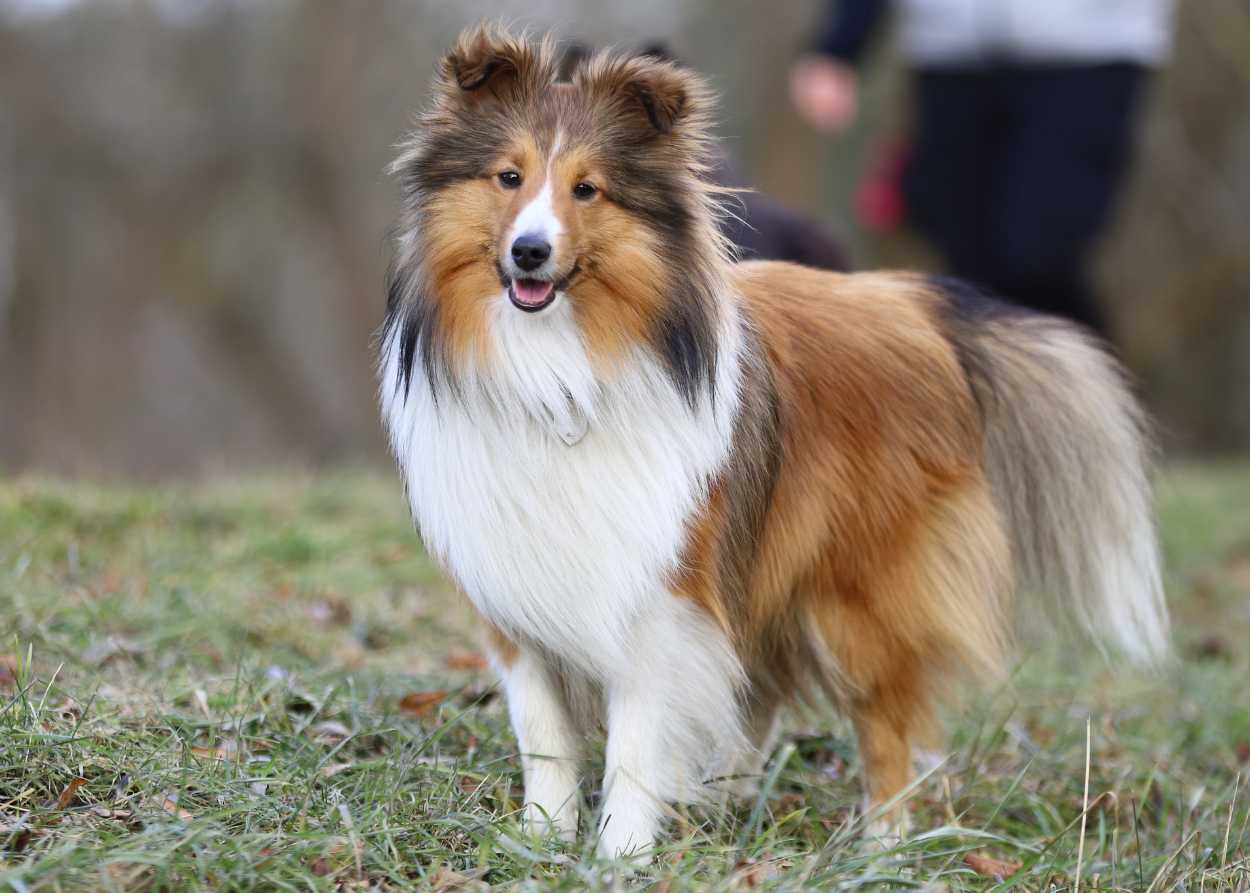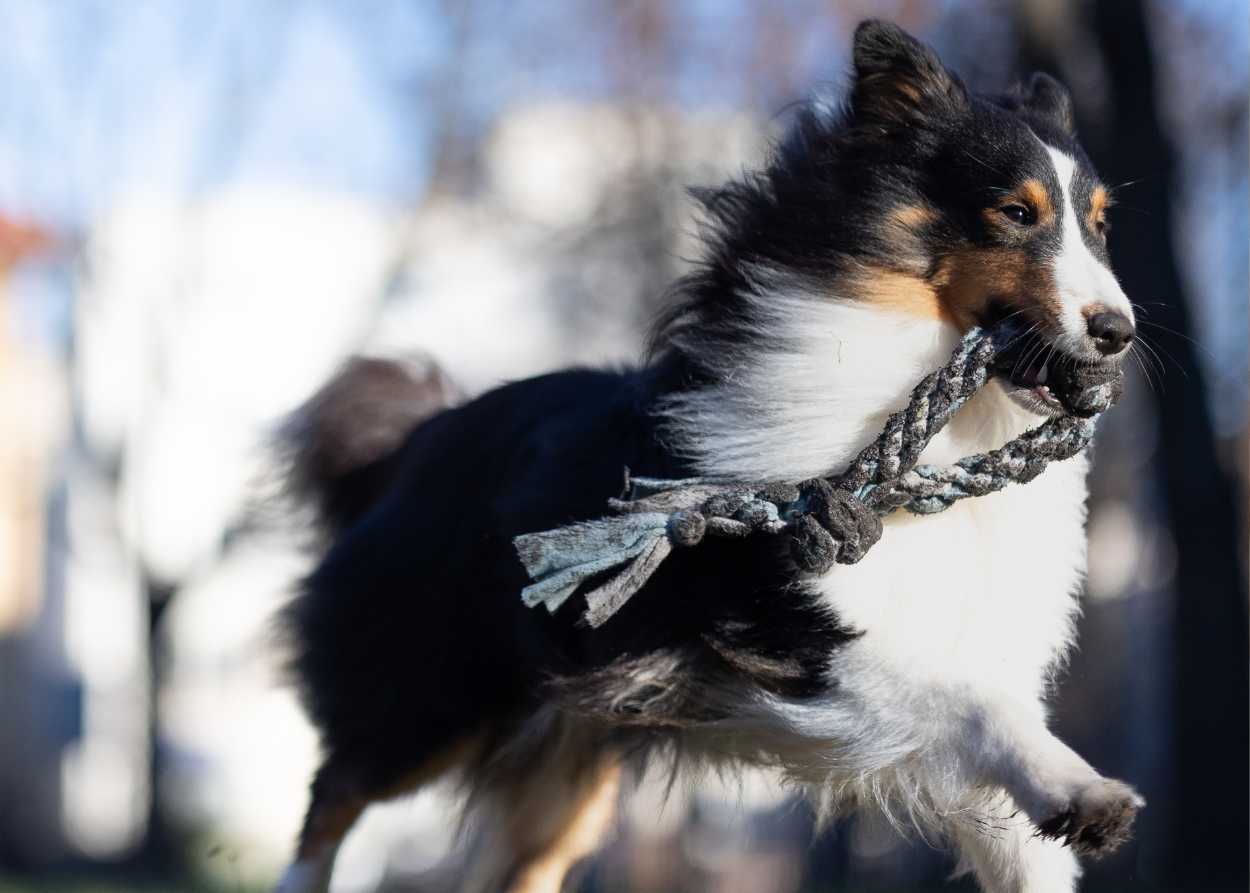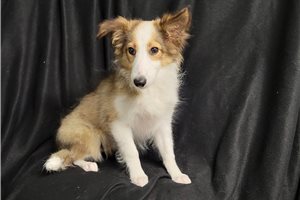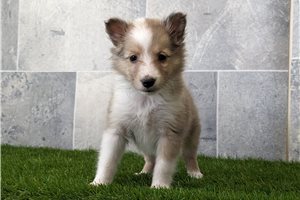Have you “herd” of the Shetland Sheepdog? Oh, you mean “Lassie?”
Not quite. Contrary to popular belief, Sheltie puppies are not miniature versions of the Rough Collie despite looking like little Lassies. They are a separate dog breed and have a breed standard developed over the last 70 years.
Shetland Sheepdogs are a joy to have in your household because they are loyal and go the extra mile for what you want them to do. They are agile, elegant athletes and smart as a whip. As a member of the herding group, the Sheltie is a source of national pride for the Shetland Islands, its homeland, playing a pivotal role in its way of life. And while they have striking features, their charming personalities will win you over the most.
If you’re already intrigued by this diminutive, delightful dog, read on to find out what it’s like living with Shetland Sheepdog puppies in our ultimate Shetland Sheepdog puppy owner guide.
The first photo of a Shetland Sheepdog, 1915
The History and Origin of the Shetland Sheepdog Breed
The Shetland Islands lie off the northeast coast of Scotland up by the Arctic Circle. This windy, cold, isolated cluster of islands is susceptible to sudden shifts in the weather across its rugged, beautiful landscape of 100 small islands. The islands boast a Scottish and Norse heritage that heavily influenced the origin of the Shetland Sheepdog.
Herding dogs have helped inhabitants of the Shetland Islands for centuries. Years of crossbreeding among large Viking breeds, with smaller, native Shetland dogs to produce a Spitz breed, similar to the modern Icelandic Sheepdog. In the 1700s, Scottish farmers introduced mainland dogs like Cavalier King Charles Spaniels, Corgis, Pomeranians, Papillons, and Rough Collies to form the “Toonie,” a nickname for this dog from the Shetland word for “farm.” It’s said that the Shetland Islands farmers wanted to keep their dogs small like their famous Shetland ponies and small cattle breeds. Small dogs also meant they didn’t require as much food and wouldn’t get in the way of the sheep. Its isolated location allowed the breed to be preserved as the small, hardy dog of modern times.
In the 1800s, tourists to the Shetland Islands fell in love with the small, bright dogs and wanted to buy Shetland Sheepdog puppies to bring back to their home countries. By 1906, Shetland Sheepdogs made their way to various parts of the United Kingdom. The breed was named the Shetland Collie. They gained official recognition with the English Kennel Club in 1909 and the American Kennel Club in 1911. One final push to breed them to Rough Collies produced the dog we see today with a new breed standard starting in 1952 separating Rough Collies from distinct, smaller Shetland Sheepdogs.
Today, Shetland Sheepdogs are #27 out of 199 dog breeds on the AKC’s Most Popular Dog Breeds of 2022 list. Various social media accounts document what life is like as a Shetland Sheepdog puppy owner.
The Importance of Herding to the Shetland Islands
Herding is one of the hallmarks of the identity of Shetland Islands inhabitants. Shetland sheep were (and still are) an integral part of the economy, as their wool and lambs were valuable commodities and crucial to their rural way of living. Shetland Sheepdogs accomplished more than one man could by helping to guard sheep from predators and keeping them in line for shepherds and farmers. Shelties also herded ponies and poultry -- any animal needing containment. Their high intelligence and trainability made them valuable assets to any farm.
In addition to being kept as companions these days, Shetland Sheepdogs still thrive as working, herding dogs. Several festivals and herding competitions held across the Shetland Islands celebrate the beloved Shetland Sheepdog. These competitions will have events where handlers communicate a series of whistles and hand signals to follow commands, where Shelties can turn or stop with precision to control a group of sheep.
What Do Sheltie Puppies Look Like?
Bred to be small in stature, a Sheltie puppy will grow to stand 13-16 in. tall and weigh 15-25 lbs. Shetland Sheepdogs are surprisingly strong even though they have delicate-looking limbs. Their tipped ears, long snout, and beautiful mane and collar give them a regal look. Some Shetland Sheepdog puppy owners say their little bright-eyed faces are very expressive and look as if they understand their humans.
A Sheltie puppy’s coat & grooming requirements
One striking feature of a Sheltie puppy is its amazing, thick double coat. Shetland Sheepdogs come in a wide range of colors and patterns including bicolor, tricolor, sable, black, mahogany, blue, merle, and more combinations. Two patterns stand out: The piebald (also called white factoring) where there is a pigmented and non-pigment mix of color, usually black and white; and the Irish pattern in Shetland Sheepdogs with white fur on the tips of their tails, bellies, legs, chest, and collar.
A Sheltie puppy's double coat serves several functions and should never be shaved. The rough, coarse outer layer is waterproof, and the undercoat is comprised of soft, downy hair that helps regulate a Sheltie’s temperature. Their weather-proof coat is a perfect protection from the unpredictable harsh weather conditions of the Shetland Islands. Shelties can get filthy running through bogs and mud. However, their coats are so slick and resistant that it can look like they’ve just stepped out of the bath the next minute.
Grooming a Shetland Sheepdog requires careful, regular maintenance. Their luxurious coats need to be brushed a few times a week with a pin brush and undercoat rake to remove dead hairs and debris and redistribute natural oils. Bathe your Sheltie puppy every 4-6 weeks. Use a gentle shampoo and condition their coats. Be sure to dry them all the way to prevent skin issues. Trim nails and keep up with proper dental care for a healthy grooming routine.
What Shetland Sheepdog Puppy Owners Want You to Know
Each dog breed has particular needs and quirks, so it’s important to see if the personality of a Shetland Sheepdog is the right fit for your family. Here are some fun facts about Sheltie puppies that you may find interesting when learning about the breed.
Sweet and affectionate
Sheltie puppies bond quickly with either one special person or the whole family. They are highly in tune with the vibe of the household and will pick up if you’re sad and need a cuddle session. They’re also sensitive and don’t like it when they think you are angry or disappointed in them, so be prepared for a lot of make-up puppy kisses to get on your good side again.
Loyal and protective
As they are used to watching over others, Shetland Sheepdog puppies are excellent watchdogs that are loyal to their owners and want to protect them from any perceived harm. Shelties are aware of their surroundings and can be reserved at times if they are unsure about a situation.
Quick and agile
It is a joy to watch a Sheltie puppy at work, zipping around with glee and zooming past you with their hair flying out from their faces like a shampoo model. Shelties always do so well at dog sports competitions requiring a timed trial. They can change directions quickly and cover long distances.
Bright and intelligent
Shetland Sheepdogs are intelligent dogs that use their active brains to work out solutions. They have an uncanny ability to remember hand signals and voice commands, often with subtle differences. They have the innate knowledge to guide livestock without harming them. Shetland Sheepdogs are also very obedient dogs when trained properly.
Training Your Sheltie Puppy
Thanks to their tireless work ethic and intelligence, training a Shetland Sheepdog puppy can be a very rewarding experience – even through setbacks.
Shelties are overall easy to train and eager to please their owners. They take to commands easily and are some of the most obedient working dogs. Using positive rewards and lots of praise is needed over harsh training methods because Shelties can be sensitive and need love to thrive, not punishment.
Some tasks may have a better success rate than others when training your Shetland Sheepdog. It’s important to train your Sheltie not to bark excessively, not an easy task without consistency and patience. You can thank their genetics. Designed to be herding dogs, Shetland Sheepdogs continuously use their high-pitched bark to warn of potential dangers and lead livestock. However, they don’t know that the wind blowing leaves around or a car driving by are not potential dangers!
As a member of the herding family, a Sheltie puppy’s instinct is to herd creatures he believes need protection and direction. If there are no sheep around, a Sheltie puppy may bark at and nip at the heels of children to round them up. Shetland Sheepdog puppies also like chasing and herding birds, squirrels, and cats. Early introduction and proper training will help control this instinct.
Shelties are generally friendly, but they can be cautious with strangers until they get to know you. Early socialization is key to producing a well-rounded Sheltie puppy to get them used to unfamiliar sights, sounds, and situations.
Caring For Sheltie Puppies
Keeping your Shetland Sheepdog puppy healthy is not something you can just hope for the best. Taking proactive steps to enhance the well-being of your Sheltie is part of being a responsible dog owner.
Exercise requirements for Sheltie puppies
Sheltie puppies are lively and very active, needing 45-60 minutes of physical exercise and mental stimulation.
There are lots of great ways to exercise your Sheltie puppy. In addition to daily walks and visits to the dog park, these dogs need mental stimulation, too. Solving puzzles and playing with interactive toys helps keep their minds occupied and focused. Shelties also love having a “job” to do. Participating in dog sports is a fun way to work on training commands and strengthen your bond, all while engaging in active challenges such as agility, trial, herding, and obedience. Make sure your puppy has an understanding of basic commands for dogs before beginning a more rigorous activity.
Possible health concerns in Shetland Sheepdogs
In addition to regular grooming, scan their bodies for any signs of parasites, infections, lumps, or other issues. Be sure to place them on preventative care for flea, tick, and heartworms and take them to vet visits regularly. You should establish a relationship with a licensed veterinarian as your partner in keeping your Sheltie puppy healthy for its lifespan of 12-14 years.
A Sheltie may experience the following health issues: Eye diseases, thyroid disease, epilepsy, dermatomyositis, gallbladder issues, and von Willebrand’s disease. Finding Shetland Sheepdog puppies from reputable breeders who have their best interests at heart and care deeply about furthering the breed standard is important when ensuring your puppy has the best start in life.
Where Can I Find Happy Shetland Sheepdog Puppies?
Congratulations! You’ve decided to become a Shetland Sheepdog puppy owner! Now your task is to find the perfect Sheltie puppy. Where to start?
If you turn to an internet search, you may be tempted to check local message boards or social media posts for cheap prices. However, those low prices could be a recipe for disaster. Reputable breeders would never allow puppies to go home before they are 8 weeks old or sell a puppy without a health guarantee, veterinary care records, a puppy contract, or accept payment via an unsecured app, cash, or MoneyGram.
Pawrade offers cute Shetland Sheepdog puppies
Pawrade is a scam-free pet adoption service that unites potential puppy owners like yourself with reputable Shetland Sheepdog breeders. Our hand-selected, pre-screened breeders know exactly how to prepare your puppy to be ready to embrace life as your loyal sidekick. All puppies go home after 8 weeks to allow a successful weaning from the mother and learn early socialization skills. Each Shetland Sheepdog puppy comes with a 3-year health guarantee, health records, and a puppy contract, all under a secure transaction management system called PetPay which sets up everything in one convenient place.
Our staff provides the ultimate Shetland Sheepdog puppy adoption experience seamlessly, from your first contact through hearing about your first few days with your Sheltie puppy.
Browse our Shetland Sheepdog puppies for sale, and let us know which one will begin your Sheltie adoption journey with you. We can’t wait to help!






